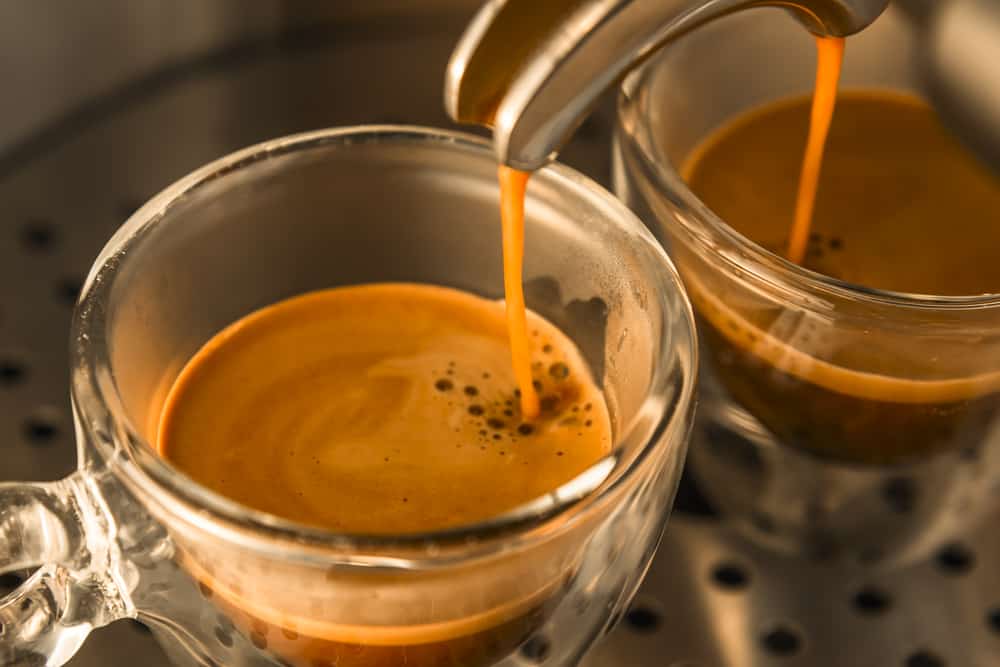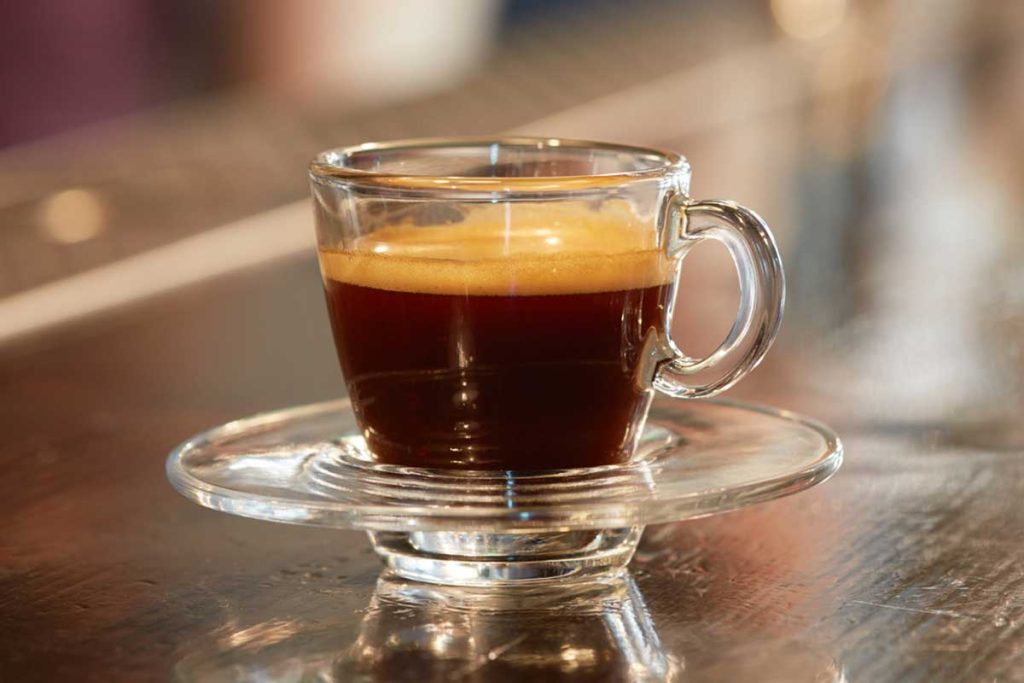How To Get Better Crema On Espresso

What Is Crema?
Crema is the golden brown layer of foam that sits atop a well pulled espresso shot. Good crema is necessary for an ideal espresso shot for its visual appeal and contribution to the overall flavor and mouthfeel of the coffee.
The presence of crema indicates a properly extracted espresso with the right balance of oils, flavors, and aromas. How can you achieve that beautiful and pronounced crema in your cup of coffee? Let’s explore some tips and techniques to enhance your espresso crema game.
Benefits Of Good Espresso Crema
Good crema production is part of creating a superior cup of espresso coffee. It enhances the espresso shot’s visual appeal and adds complexity and depth to the flavor profile.
An ideal espresso crema has a rich, golden brown color and a creamy, velvety consistency. It forms a beautiful layer on the coffee, creating an inviting visual experience.
The presence of crema indicates a proper extraction process, where the coffee oils and flavors are effectively extracted from the beans. The crema traps and releases aromatic compounds, contributing to a fuller and more pronounced flavor.
When combined with the best coffee beans for crema and proper brewing methods, the crema elevates the taste experience to new heights. It adds a smoothness to the coffee, balancing and mellowing out any harsh or bitter notes while highlighting the underlying flavors.
The Basics Of Getting Better Crema
Coffee Selection:
Fresh Coffee Beans
Freshly roasted coffee beans retain a significant amount of carbon dioxide. This gas leads to the formation of crema. During roasting, beans release carbon dioxide, which, when trapped, creates the foamy layer on top of your espresso. The presence of this crema is a sign of a properly extracted shot of espresso and contributes to the depth and complexity of your coffee’s flavor.
Freshly roasted coffee beans are bursting with aromatic compounds that contribute to espresso’s enticing fragrance and flavor. These compounds include volatile oils and aromatic molecules. Using fresh beans ensures these aromatics are at their peak, enhancing the overall sensory experience.
Give Fresh Beans a Break
Using fresh coffee beans that were roasted within the last few days can create challenges in the espresso making process. These challenges include excessive carbon dioxide release, which can lead to an unstable and frothy crema, potential issues with channeling and uneven espresso extraction, and the possibility of underdeveloped sweetness in the espresso’s flavor. Allowing beans to rest for a few days to a week after roasting can help address these issues and lead to a more stable crema and a well balanced cup of espresso.
Roasting Process & Lighter Roasts
The roasting process does impact the production of crema. Contrary to popular belief, lighter roasts excel in crema production. The common myth that dark roasted beans result in more crema should be debunked.
Lighter roasts preserve more of the coffee bean’s natural oils, which assist in the formation of crema. These oils, combined with the hot water and pressure during brewing, create the foamy layer we all love. Dark roasted beans, on the other hand, have their oils pushed to the surface during the roasting process, resulting in less crema production.
For beginners, medium dark to medium roasted beans are the sweet spot for crema production. These roasts offer a slightly more forgiving brew time and water temperature range, allowing for a wider margin of error while still producing a delicious crema.
Preparing Your Coffee Beans:
Proportions & Rule Of Thumb
Proportions are vital for achieving more crema and flavor in your espresso. A common starting point is the 1:2 brew ratio, where 1 gram of ground coffee yields 2 grams of liquid espresso. This balance ensures a full flavor and rich crema.
Experimenting with brew ratios can be exciting for coffee enthusiasts. Some people prefer a stronger, more concentrated shot, while others enjoy a milder flavor. Adapting the brew ratio allows you to cater to your taste preferences and explore the different flavor profiles that can be achieved.
Remember, the perfect brew ratio is a guideline, and it’s worth experimenting to find your ideal ratio. The right proportions, combined with the proper extraction process, will help you achieve the perfect crema and a satisfying cup of espresso every time.
Dosing And Weighing
Achieving balanced extraction relies on using the right amount of coffee grounds, a process known as dosing. Dosing involves accurately measuring the coffee grounds for each espresso shot. Weighing the grounds ensures consistency by using the same amount for every shot. This consistency is vital because it enables you to predictably control your espresso’s flavor profile, crema thickness, and overall quality.
Portafilter Basket Selection
Portafilters come in various sizes, typically single, double, or triple shots. A larger portafilter can hold more coffee grounds, allowing for a higher coffee to water ratio, which often leads to a fuller flavor and thicker crema. On the other hand, a smaller portafilter may result in a weaker and less pronounced crema.
The material of the portafilter matters for crema quality. Opting for a high quality portafilter made of materials like stainless steel or brass provides better heat retention and stability during the brewing process. This ensures a consistent and even extraction, allowing the coffee’s full flavor potential to be extracted into the cup.
Correct Grind Size
The grind size directly impacts the rate at which water passes through the coffee grounds during the brewing process. When the grind size is consistent and appropriate for espresso, it ensures a uniform extraction. This means that each coffee particle is exposed to water for the same amount of time, resulting in a well balanced shot of espresso with a harmonious combination of flavors.
The ideal grind size for achieving the perfect crema in espresso typically falls in the fine to medium fine range. The precise grind size can vary depending on factors like the coffee beans, the espresso machine, and personal preference. You should experiment and make adjustments to find the best grind size for your specific setup and taste preferences.
Proper Tamping
Tamping is the process of compressing the coffee grounds in the portafilter evenly. When done correctly, it creates a uniform coffee puck. This even distribution of coffee grounds allows consistent water flow through the puck during extraction. When the grounds are evenly tamped, the water can pass through them uniformly, extracting flavors evenly and resulting in a well balanced shot.
Brewing Process:
Good Quality Espresso Machine
A high quality espresso machine provides precise control over the water pressure used during extraction. Coffee crema formation relies on the right amount of pressure, typically around 9 bars, to properly emulsify coffee oils and carbon dioxide gas. A good machine ensures consistent pressure, creating a rich and creamy crema.
Maintaining the correct water temperature improves crema quality. Espresso machines with advanced temperature stability features, such as PID (Proportional Integral Derivative) controllers, allow for precise control over the water temperature. This helps prevent over extraction or under extraction, leading to a balanced and flavorful crema.
Some high quality machines offer pre infusion capabilities. Pre infusion involves briefly saturating the coffee grounds with water before applying full pressure. This gentle start to the extraction process helps with even extraction, promoting a thick and velvety crema.
Correct And Consistent Water Pressure
The correct water pressure ensures a stable foam and optimal extraction. The ideal range for water pressure in espresso machines is typically 9 bars. It’s recommended to check your espresso machine’s specific pump pressure setting, as different machines may have slightly different requirements.
Maintaining the correct water pressure is vital for consistent and quality espresso. The crema may be light and thin if the pressure is too low. Excessively high pressure can lead to a dark and bitter extraction. It’s helps to regularly clean your espresso machine, as a dirty machine can affect water pressure and result in lousy crema production.
Proper Water Temperatures
Hot water, typically between 195°F to 205°F (90°C to 96°C), extracts the complex flavors and aromatic compounds from the coffee grounds. The heat helps break down the soluble compounds in the coffee, allowing them to dissolve and infuse into the water. This extraction process contributes to a well balanced and flavorful espresso shot.
If the water is too hot, above 94°C (201°F), it can lead to over extraction. Over extraction occurs when the water stays in contact with the coffee grounds for too long, extracting excessive amounts of bitter compounds. This can result in a thin, dark brown to blackish crema with a white spot or a black hole in the center, indicating a poorly extracted shot.
Water Quality
High quality, purified water ensures that the natural flavors of the coffee shine through. Impurities or off flavors in water can negatively impact the taste and aroma of the espresso, detracting from the overall crema quality.
The mineral content of water significantly affects the extraction process. Water that is too soft lacks the necessary minerals, such as calcium and magnesium, to effectively extract flavor compounds from coffee grounds. On the other hand, water that is too hard, with excessive mineral content, can lead to over extraction and unpleasant flavors. The ideal water should have a balanced mineral composition for optimal crema formation and flavor extraction.
Extraction Time
The extraction time directly influences the balance of flavors in your espresso. An ideal extraction time, typically around 25-30 seconds, allows for the proper dissolution of soluble compounds in the coffee grounds. This results in well balanced espresso shots with a harmonious combination of sweetness, acidity, and bitterness. A shorter extraction time may lead to under extraction, resulting in a thin, weak crema and sour taste, while a longer extraction time can lead to over extraction, causing excessive bitterness and a coarse crema.
Essential Factors For Brewing A Superior Espresso Shot

Producing a great espresso with a quality crema requires several factors. These factors include using freshly roasted beans, correctly grinding the coffee, tamping it evenly, maintaining the proper brew ratio, ensuring good water quality, employing a high quality espresso machine, selecting the appropriate portafilter, mastering the espresso brewing technique, and regularly maintaining equipment. These elements collaborate to yield a visually appealing and satisfying espresso.
Given the wide range of taste preferences, coffee enthusiasts should adjust these factors to create a personalized espresso experience that aligns with their unique flavor preferences.
Alex is a web developer, writer, and marketer. He has degrees in English, Computer Science, and Mathematics and is always learning as much as he can. Alex operates a series of websites for both client and personal use. Alex usually starts the day with shot of espresso or an Americano and then follows up with a Cafe Au Lait with lunch. He enjoys trying new coffee beans and finding new ways to prepare it, but most days prefers to keep things simple.





